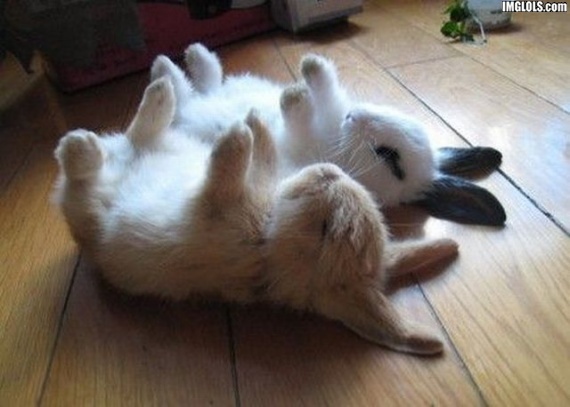Rabbit Behavior

Nowadays, we have a far greater understanding of what rabbits need to keep them happy and healthy. It is also important to remember that the way a rabbit behaves will depend on their age, personality and past experiences.
Rabbits are prey animals first and foremost and their natural response to a perceived threat is to often run and hide. They have a wonderful ability to interact with humans but need time and regular, gentle handling from an early age to become comfortable around humans.
Offer your rabbits’ lots of bolt holes/hiding within their home and areas they have access to. Open spaces with no protection will cause your rabbits to feel under threat. A good idea is to place the carrier inside the homing area so increase familiarity and reduce stress during vet visits.
Think about what other animals are already in your house, and whether they are a natural predator to rabbits. For example rabbits will feel scared being housed next to dog kennels or ferret enclosures! Make sure your rabbits can always escape and hide if they feel afraid.
If a rabbit’s behavior changes or they show regular signs of stress or fear (such as frequent hiding or being aggressive to you/or other pets), they may be in pain, distressed and /or suffering emotionally. You should get your pet checked by a vet to rule out any form of illness or injury that could be causing the behavior problem. Your vet can then refer you to a behaviour expert if necessary.
Create a ‘wild’ environment for your rabbits
In the wild, rabbits have plenty to keep them occupied, from foraging to reproduction to territorial defence. Pet rabbits, on the other hand, often lack stimulation, which can lead to behavioural problems and poor health. Much like humans, they need to be kept physically and mentally active. You can replicate a rabbit’s natural environment by providing some of the items below:
- Tunnels (that are wide enough for the rabbits to pass through easily)
- Tree stumps (from trees that are safe for rabbits to chew, e.g. apple, that have not been sprayed with chemicals) to act as look out points (platforms)
- Safe, unsprayed twigs (which can be hung up so that they can pull them)
- Suitable toys (there are many rabbit toys available commercially; ensure any you buy are safe and that your rabbits use them)
- Digging Box i.e. A planter filled with earth for digging
- Platforms for hiding under and climbing on
- Constant access to safe hiding places (such as cardboard boxes)
- Games, such as food items in brown paper which they have to unwrap
- Put food in multiple places so they have to move around to find it
- Use food balls (the treat balls made for cats work well) to feed their nuggets as they will spend longer eating and have fun chasing them around
Digging
Digging is a favourite pastime of rabbits, both domestic and wild. By providing digging substrates, such as a child’s sand pit or wide plant pot filled with earth or child-safe play sand, your pet rabbits will be able to dig away without damaging your garden or escaping.
Marking
Rabbits’ homes are their castles and in the wild they are very protective of their territory, marking out anything they see as theirs using chin secretions, urine and droppings. These markings also help them to feel reassured as their environment smells familiar. Pet rabbits will also display these behaviours and you should allow them to do so.
Variety
Just like humans, rabbits become bored if their environment remains the same, so consider an occasional change of scenery. However, be careful as too much change can be stressful. Wild rabbits’ survival depends on an intimate knowledge of their surroundings in order to escape from predators, so structural changes to your pet rabbits’ ‘warren’ should be kept subtle, such as changing their toys and regularly providing new ones
http://www.burgesspetcare.com/your-pet/rabbits/caring-for-your-rabbit/

..
No comments:
Post a Comment